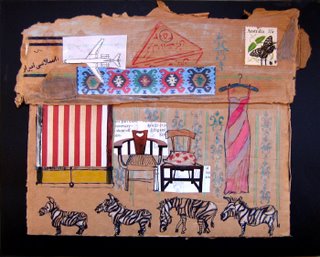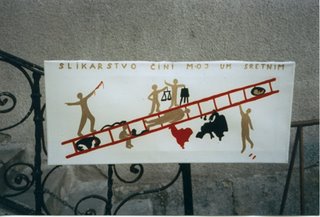Saturday, December 16, 2006
by
ivana krauz
at
22:14
7
thoughts
![]()
Saturday, December 09, 2006
Saturday, November 25, 2006
Friday, November 10, 2006
Sunday, November 05, 2006
Friday, November 03, 2006
Thursday, November 02, 2006
Wednesday, November 01, 2006
Thursday, October 26, 2006
october salon
by
ivana krauz
at
12:45
0
thoughts
![]()
umetnost,zivot pometnja & confusion
naziv ovogodishnjeg beogradskog oktobarskog salona,,,
sve nekako u znaku boysa
lepe su razglednice sa imaginarnih mesta,,kao neka daleka secanja
ples argentinca sa stvarnom nestvarnom zenom lutkom,,
chisti lepi crtezi skandinavaca,,kao njihova cela kultura zivljenja-prochishceno,jednostavno
alen karpov-gume u dvorishtima americhkim:
1
The key experiment was not simply the invention of new art genres by which the period is usually known, but the recognition of the secularization of the entire art situation: genre, frame, public and purpose.
2
The critical move in the experiment was the shift of art away from its familiar contexts, the studios, museums, concert halls, theatres etc., to anywhere else in the real world.
3
Various performative modes became the effective way to deal with this shift to the actual environment. Performing was doing something, not acting in theatre — moving furniture, for example, just to do it, or because you were changing apartments.
4
The structural models for the experiment were real (not merely implicit) processes: for example, seasonal changes; food that is grown, prepared, eaten, digested and composted; thoughts that are transmitted, converted and put into action.
5
The possible boundaries between lifelike art and the rest of life were kept intentionally blurred. Where the art was located and where life was, when one or the other “began” and “ended,” was of no importance. Such distinctions were merely provisional.
6
The typical art public and critic used to going to exhibitions, concerts and plays, became irrelevant. Instead, there were small groups of travellers to far-off sites, participants in organised events, thinkers on commuter trains and artists in their art by themselves. The emerging public for this lifelike art was no longer ideal and unified, but was diversified, mobile and particular in interests, like people in the real world.
7
Lifelike art did not merely label life as “art”. It was continuous with that life, inflecting, probing, testing and even suffering it, but always attentively. (That’s the source of its humour, when you look closely at your suffering, it can be pretty funny ...)
8
The purpose of lifelike art was therapeutic: to reintegrate the piecemeal reality we take for granted. Not just intellectually, but directly, as experience — in this moment, in this house, at this kitchen sink...
Allan Kaprow
Excerpt from “The Real Experiment”, Artforum, December 1983
The key experiment was not simply the invention of new art genres by which the period is usually known, but the recognition of the secularization of the entire art situation: genre, frame, public and purpose.
2
The critical move in the experiment was the shift of art away from its familiar contexts, the studios, museums, concert halls, theatres etc., to anywhere else in the real world.
3
Various performative modes became the effective way to deal with this shift to the actual environment. Performing was doing something, not acting in theatre — moving furniture, for example, just to do it, or because you were changing apartments.
4
The structural models for the experiment were real (not merely implicit) processes: for example, seasonal changes; food that is grown, prepared, eaten, digested and composted; thoughts that are transmitted, converted and put into action.
5
The possible boundaries between lifelike art and the rest of life were kept intentionally blurred. Where the art was located and where life was, when one or the other “began” and “ended,” was of no importance. Such distinctions were merely provisional.
6
The typical art public and critic used to going to exhibitions, concerts and plays, became irrelevant. Instead, there were small groups of travellers to far-off sites, participants in organised events, thinkers on commuter trains and artists in their art by themselves. The emerging public for this lifelike art was no longer ideal and unified, but was diversified, mobile and particular in interests, like people in the real world.
7
Lifelike art did not merely label life as “art”. It was continuous with that life, inflecting, probing, testing and even suffering it, but always attentively. (That’s the source of its humour, when you look closely at your suffering, it can be pretty funny ...)
8
The purpose of lifelike art was therapeutic: to reintegrate the piecemeal reality we take for granted. Not just intellectually, but directly, as experience — in this moment, in this house, at this kitchen sink...
Allan Kaprow
Excerpt from “The Real Experiment”, Artforum, December 1983
by
ivana krauz
at
10:09
0
thoughts
![]()
Tuesday, October 24, 2006
by
ivana krauz
at
14:32
2
thoughts
![]()
Sunday, October 15, 2006
Subscribe to:
Comments (Atom)
















